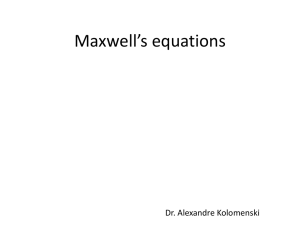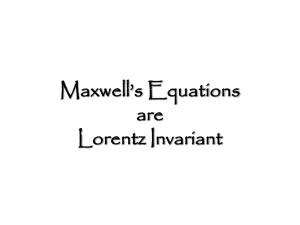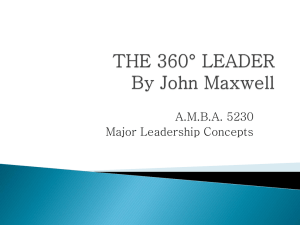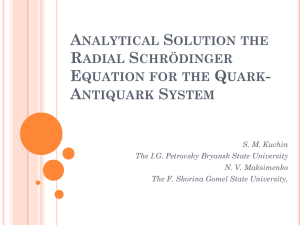the Aharanov-Bohm Effect - Colorado Mesa University
advertisement
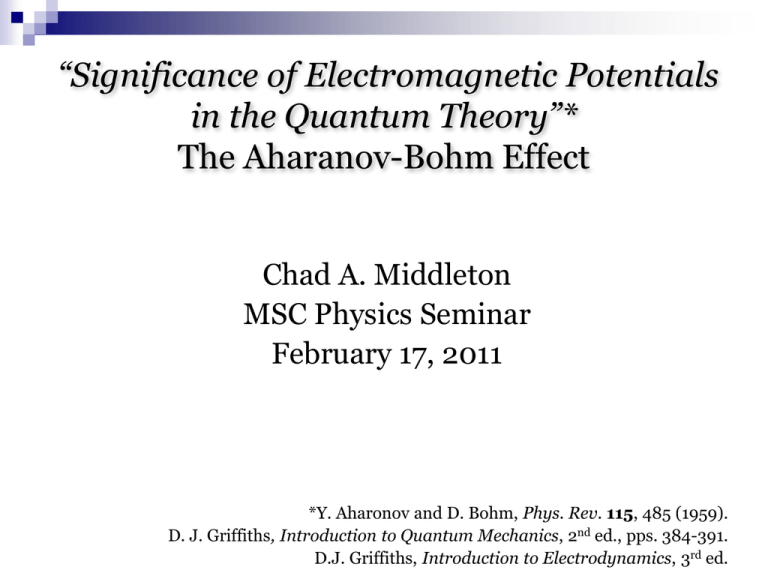
“Significance of Electromagnetic Potentials in the Quantum Theory”* The Aharanov-Bohm Effect Chad A. Middleton MSC Physics Seminar February 17, 2011 *Y. Aharonov and D. Bohm, Phys. Rev. 115, 485 (1959). D. J. Griffiths, Introduction to Quantum Mechanics, 2nd ed., pps. 384-391. D.J. Griffiths, Introduction to Electrodynamics, 3rd ed. http://www.nsf.gov/od/oia/activities/medals/2009/laureatephotos.jsp Yakir Aharonov receives a 2009 National Medal of Science for his work in quantum physics which ranges from the Aharonov-Bohm effect to the notion of weak measurement. Outline… Maxwell’s equations in terms of E & B fields Scalar and vector potentials in E&M Maxwell’s equations in terms of the potentials Schrödinger equation Schrödinger equation with E&M Aharonov-Bohm Effect A simple example Maxwell’s equations in differential form (in vacuum) E Gauss’ law for E-field 0 B 0 E Gauss’ law for B-field B t B 0 0 0 Faraday’s law E Ampere’s law with Maxwell’s correction t 0J these plus F q E v B the Lorentz force completely describe classical Electromagnetic Theory Taking the curl of the 3rd & 4th eqns (in free space when = J = 0) yield.. 2 2 1 2 2 E 0 c t 2 2 1 2 2 B 0 c t The wave equations for the E-, B-fields with predicted wave speed c 1 0 0 3.0 10 m / s 8 Light = EM wave! Maxwell’s equations… E Gauss’ law for E-field 0 B 0 E Gauss’ law for B-field B t B 0 0 0 Faraday’s law E Ampere’s law with Maxwell’s correction t 0J Q: Can we write the Maxwell eqns in terms of potentials? E, B in terms of A, Φ… B A E A t Φ is the scalar potential A is the vector potential Write the (2 remaining) Maxwell equations in terms of the potentials. Maxwell’s equations in terms of the scalar & vector potentials 2 A t Gauss’ Law 0 2 2 0 0 2 A A 0 0 0 J t t Ampere’s Law Gauge invariance of A, Φ.. B A E A t Notice: E & B fields are invariant under the transformations: t for any function ( r , t ) A A A Show gauge invariance of E & B. Maxwell’s equations in terms of the scalar & vector potentials 2 A t Gauss’ Law 0 2 2 0 0 2 A A 0 0 0 J t t Ampere’s Law Coulomb gauge: A 0 Maxwell’s equations become.. 0 2 2 2 0J 0 0 2 A 0 0 t t Easy Hard Gauss’ law is easy to solve for , Ampere’s law is hard to solve for A Maxwell’s equations in terms of the scalar & vector potentials 2 A t Gauss’ Law 0 2 2 0 0 2 A A 0 0 0 J t t Ampere’s Law Lorentz gauge: A 0 0 t 0 Maxwell’s equations become.. 2 2 0 0 2 t 0 2 2 0 0 2 A 0 J t Lorentz gauge puts scalar and vector potentials on equal footing. Schrödinger equation for a particle of mass m 2 2 V i t 2 m where is the wave function with physical meaning given by: dP d x * 3 How do we include E&M in QM? Schrödinger equation for a particle of mass m and charge q in an electromagnetic field 1 i qA 2 m 2 q i t is the scalar potential A is the vector potential InQM, the Hamiltonian is expressed in terms of , A and NOT E , B . Gauge invariance of A, Φ.. Notice: E & B fields and the Schrödinger equation are invariant under the transformations: t A A A e for any function ( r , t ) iq / Since and differ only by a phase factor, they represent the same physical state. The Aharonov-Bohm Effect http://physicaplus.org.il/zope/home/en/1224031001/Tonomura_en In 1959, Y. Aharonov and D. Bohm showed that the vector potential affects the behavior of a charged particle, even in a region where the E & B fields are zero! A simple example: Consider: A long solenoid of radius a A charged particle constrained to move in a circle of radius b, with a < b Magnetic field of solenoid: B B 0 kˆ B0 ra ra Vector potential of solenoid? (in Coulomb gauge) A simple example: Consider: A long solenoid of radius a A charged particle constrained to move in a circle of radius b, with a < b Magnetic field of solenoid: B B 0 kˆ B0 ra ra Vector potential of solenoid? (in Coulomb gauge) A B 2 r eˆ , r a Notice: The wave function for a bead on a wire is only a function of the azimuthal angle ( ) eˆ as 1 d b d r b, /2 Notice: The wave function for a bead on a wire is only a function of the azimuthal angle ( ) eˆ as r b, /2 1 d b d The time-independent Schrödinger eqn takes the form.. 2 2 2 2 1 d q B d q B i 2 E 2 2 2 2 b d 4 b 2 m b d The time-independent Schrödinger equation yields a solution of the form.. ( ) Ae i where q B 2 b 2 mE Notice: The wave function must satisfy the boundary condition ( ) ( 2 ) e i 2 1 this yields… q B 2 b 2 mE n where n 0,1, 2, ... Finally, solving for the energy… q B where n 0,1,2,... En n 2 2 mb 2 2 2 Notice: positive (negative) values of n represent particle moving in the same (opposite) direction of I. Finally, solving for the energy… q B where n 0,1,2,... En n 2 2 mb 2 2 2 Notice: positive (negative) values of n represent particle moving in the same (opposite) direction of I. particle traveling in same direction as I has a lower energy than a particle traveling in the opposite direction. Finally, solving for the energy… q B where n 0,1,2,... En n 2 2 mb 2 2 2 Notice: positive (negative) values of n represent particle moving in the same (opposite) direction of I. particle traveling in same direction as I has a lower energy than a particle traveling in the opposite direction. Allowed energies depend on the field inside the solenoid, even though the B-field at the location of the particle is zero!

